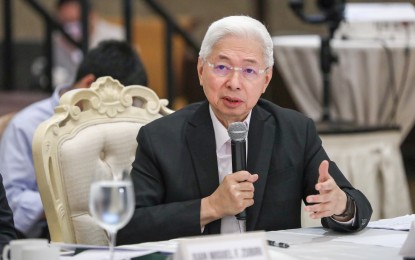[4.20] RCEP, PH 6월 2일 발효
컨텐츠 정보
- 14,522 조회
본문
마닐라 – RCEP(역내 포괄적 경제 파트너십)가 6월 2일 필리핀에서 발효될 것이라고 통상산업부(DTI) 장관 "Alfredo Pascual"이 목요일 말했습니다.
RCEP에 따른 관세 약속은 정부가 4월 3일 아세안 사무총장에게 비준서를 기탁한 후 60일 후에 시행될 것이라고 그는 말했습니다.
"Pascual"은 "Ferdinand R. Marcos Jr." 대통령이 의장을 맡은 NEDA(National Economic and Development Authority) 이사회에 RCEP 협정에 따라 국가의 관세 약속 이행을 운영할 행정 명령(EO)을 제출했습니다.
그는 6월 2일 새로운 자유무역협정(FTA)이 발효될 때까지 대통령이 EO에 서명할 것이라고 말했습니다.
"일단 발행된 EO는 RCEP 회원국으로부터의 수입품에 대한 특혜관세를 시행할 수 있도록 모든 항구에 배포될 관세행정명령 발행을 위한 관세청의 기초가 될 것입니다."라고 그는 말했습니다. 궁전 브리핑.
"Pascual"은 EO가 NEDA 위원회의 권고에 따라 대통령이 대외 무역을 수행하고 촉진하는 데 필요하거나 적절한 분류 및 기타 수입 제한의 필요한 변경을 포함하여 수입 관세를 수정할 수 있도록 허용할 것이라고 말했습니다.
그는 EO가 1,718개의 농업 관세 항목 중 98.1%와 8,102개 산업 관세 항목 중 82.7%의 현재 특혜 관세를 유지할 것이라고 말했습니다.
"Pascual"은 현재 요율이 유지되는 1,685개의 농업 관세 항목 중 1,426개는 0으로 유지되는 반면 154개는 각각의 최혜국(MFN) 요율을 유지하고 모든 형태의 관세 양보에서 제외될 것이라고 말했습니다.
파이프라인에서 민감하고 매우 민감한 목록에 있는 약 105개의 농업 관세 항목은 일반적으로 MFN 요율보다 낮지만 RCEP 20년차까지 ASEAN+1 요율과 동등하거나 더 높아야 합니다.
파스쿠알 대변인은 "나머지 33개 라인은 중요한 33개 라인으로 EU는 발효 시 관세율을 인하하거나 15~20년에 걸쳐 점진적인 인하를 시행할 것"이라며 정부가 이를 검토할 것이라고 덧붙였다. 관세 라인, 특히 필리핀에서 생산되지 않는 농산물.
"파스쿠알"은 필리핀이 서명국인 새로운 FTA를 기업이 활용할 것을 촉구했습니다.
"우리는 기업이 RCEP 조항을 이행하는 데 추가로 도움을 줄 수 있는 가능한 지원을 위해 기업을 위한 지원 센터를 설립하기 시작할 것입니다."라고 그는 덧붙였습니다.
상원은 지난 2월 RCEP 비준에 동의했다. RCEP 참가국들이 2020년 11월 협상을 타결한 지 2년 만인 2023년 11월 21일.
필리핀은 15개국 중 마지막으로 협정을 비준했다.
RCEP 참가국은 협정에서 탈퇴한 인도를 제외한 10개 아세안 회원국과 FTA 상대국으로 구성된다.
RCEP의 일부인 ASEAN+1 파트너에는 호주, 뉴질랜드, 중국, 일본 및 한국이 포함됩니다. (PNA)
This is the Oriignal Articl fom PNA NEWS
[4.20] RCEP to enter into force in PH June 2
MANILA – The Regional Comprehensive Economic Partnership (RCEP) will enter into force in the Philippines on June 2, Department of Trade and Industry (DTI) Secretary "Alfredo Pascual" said Thursday.
Tariff commitments under the RCEP will be implemented in the country 60 days after the government deposited the instrument of ratification with the ASEAN Secretary General on April 3, he said.
"Pascual" presented to the National Economic and Development Authority (NEDA) Board, chaired by President "Ferdinand R. Marcos Jr.," the executive order (EO) that would operationalize the implementation of the country’s tariff commitments under the RCEP agreement.
He said the EO would be signed by the Chief Executive anytime soon or until the entry into force of the new free trade agreement (FTA) on June 2.
“Once issued, the EO shall be the basis of the Bureau of Customs for the issuance of Customs Administrative Order, which shall be distributed to all ports to allow for the implementation of the preferential tariffs on imports from RCEP member countries,” he said in a Palace briefing.
"Pascual" said the EO would allow the President to modify import duties, including necessary changes in classification and other import restrictions as required or appropriate to carry out and promote foreign trade, upon recommendation of the NEDA Board.
He said the EO would maintain the current preferential tariffs of 98.1 percent of the 1,718 agricultural tariff lines and 82.7 percent of the 8,102 industrial tariff lines.
"Pascual" said of the 1,685 agricultural tariff lines that are retained at current rates, 1,426 are maintained at zero, while 154 would remain in their respective most favored nation (MFN) rates and excluded in any form of tariff concessions.
In the pipeline, about 105 agricultural tariff lines, which are in the sensitive and highly sensitive list, shall be generally lower than the MFN rates but still higher or at par with the ASEAN+1 rates by the 20th year of the RCEP.
“For the remaining 33 lines, these are the important 33 lines, the EO will reduce tariff rates upon entry into force or implement gradual reduction over a period of 15 to 20 years,” "Pascual" said, adding that the government will examine these tariff lines, particularly agricultural products that are not being produced in the Philippines.
"Pascual" urged businesses to take advantage of the new FTA, of which the Philippines is a signatory.
“We’ll start establishing assistance centers for businesses for possible assistance that we might be able to give to further help them implement the RCEP provisions,” he added.
The Senate concurred with the RCEP ratification on Feb. 21, 2023, two years since the RCEP participating countries concluded the negotiations in November 2020.
The Philippines was the last among 15 countries to ratify the agreement.
The RCEP participating countries are composed of the 10 ASEAN member nations and its FTA partners, except India, which pulled out its participation from the agreement.
ASEAN+1 partners that are part of the RCEP include Australia, New Zealand, China, Japan, and South Korea. (PNA)
관련자료
-
이전
-
다음


